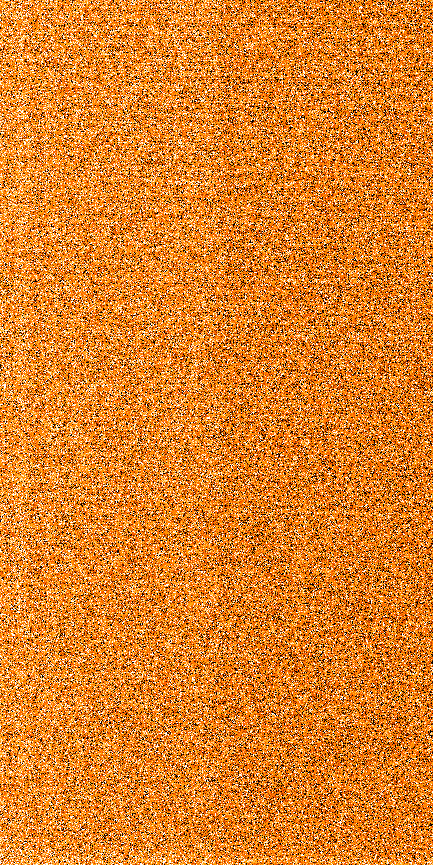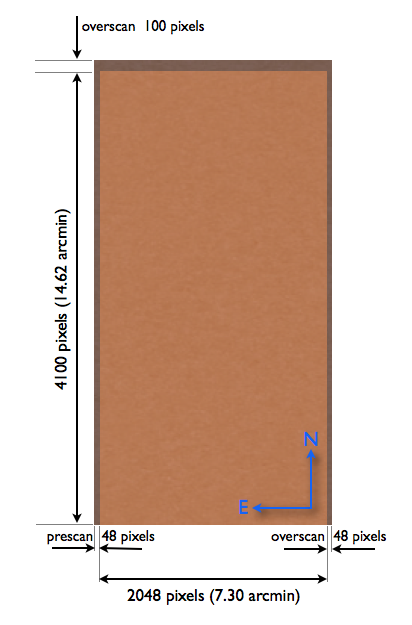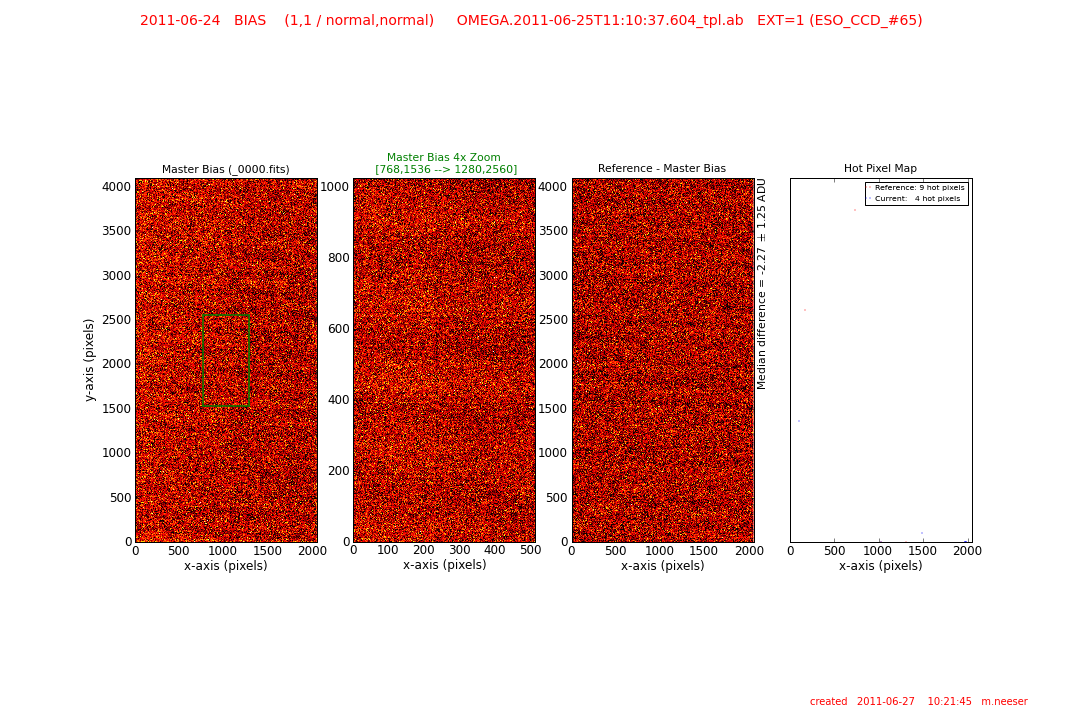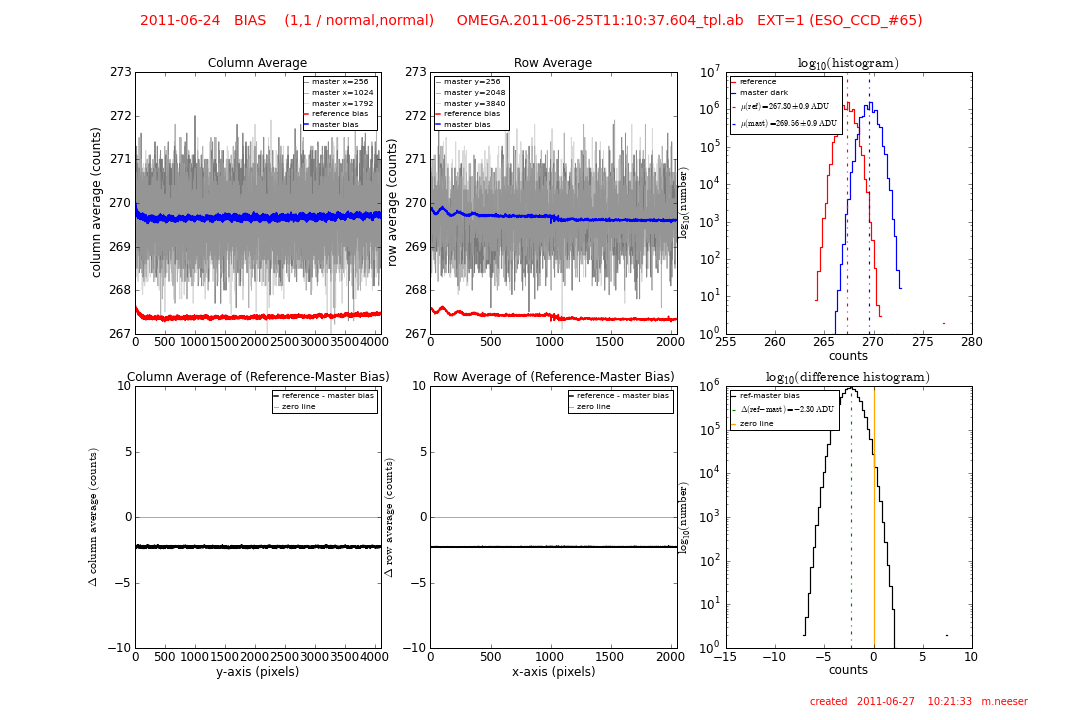| |
| QC PLOTS |
| BIAS: |
CURRENT |
HISTORY |
| bias level |
 |
 |
| read-out noise |
 |
 |
| read-out noise for selected CCDs |
 |
 |
| bias level for selected CCDs |
 |
 |
| hot pixels |
 |
 |
| |
| QC1 database (advanced users):
browse
|
plot |
Click on CURRENT to see the current trending (Health Check).
Click on HISTORY to see the historical evolution of the trending. |
BIAS frames are taken on a daily basis during normal VST/OmegaCAM operations. They are usually obtained during day-time calibration and consist of 10, zero second, closed shutter, raw bias exposures.
From this, the pipeline creates two output frames from its bias recipe (omega_mbias):
a master bias (OC_MBIA_<date>_1_1_normal_normal.fits) and a hot pixel mask (OC_MHPM_<date>_1_1_normal_normal.fits). The master bias frame is created from the 10 input raw bias frames averaged together with a 5sigma rejection of outliers (where sigma is defined from the dispersion of each pixel through the 10 input frames). The master bias is used for all subsequent processing and the hot pixel map is used in the flat field recipe in order to create a master bad pixel map consisting of both the hot and cold pixels.
 |
An OmegaCAM master bias (single detector) as computed from 10 raw bias frames (zero exposure time, opaque filter). |
 |
An OmegaCAM master hot pixel map (single detector). A value of 1 indicates a hot pixels; otherwise 0.
|
 A schematic of the geometry of an individual OmegaCAM CCD. A schematic of the geometry of an individual OmegaCAM CCD.
top
BIAS parameters trended
|
QC1 Health Check Plots
The QC1 health check plots for the OmegaCAM BIAS frames are divided into 5 separate linked pages, each of which shows the trending for a number of bias-specific QC parameters. The QC1 BIAS health check plots include:
- bias level
- read-out noise
- read-out noise for a select number of detectors (ESO_CCD #81, #82, #83, and #75)
- bias level for a select number of detectors (ESO_CCD #81, #82, and #83)
- number of hot pixels
QC1 parameters (trended for each individual detector)
| Parameter |
Table: Name (QC1 database) |
Description of Procedure |
| median level of bias frame |
omegacam_bias: qc.bias.median |
The median level of the master bias frame for each extension (ADU). |
mean level of bias frame
|
omegacam_bias: qc.bias.mean |
The mean level of the master bias frame for each extension (ADU). |
| standard deviation of bias frame |
omegacam_bias: qc.bias.std |
The standard deviation of the master bias frame for each extension (ADU). |
| number of hot pixels |
omegacam_bias: qc.bias.hotpixels |
The number of hot pixels detected in the master bias frame for each extension. The hot pixels are derived by thresholding.
First the mean (Mean) and the standard deviation (Stdev) is derived
on the master_BIAS. Then all pixels exceeding "Mean" +
"rej-sigma" * "Stdev" are marked as hot pixels. "rej-sigma" is a
recipe parameter with the default values:
--rej-sigma : Rejection threshold for outlying pixels in Hot Pixels Map. [5.0]
|
| fixed-pattern noise |
omegacam_bias: qc.fpn |
A central region [{100, 100)-->(1948, 4000)] of the master bias frame is defined, shifted by 10 pixels in both x and y, and subtracted from itself. The statistics of this difference image determines the fixed pattern noise (ADU). This parameter is defined for each CCD. |
| average temperature of the two detector plate probes |
omegacam_bias: qc.temp.mosaic.plate |
The average value of the header temperature keyword DET.TLM5 and DET.TLM8, both of which probe the temperature of the mosaic plate (Kelvin). |
| difference in median level between the current and reference bias |
omegacam_bias: qc.delta.bias.median |
The median difference between the reference - current master bias for each extension (ADU). |
| difference in the number of hot pixels between the current and reference bias |
omegacam_bias: qc.delta.bias.hotpixel |
The difference in the number of hot pixels between the reference and current master bias frames for each extension. |
| difference in the fixed-pattern-noise between the current and reference bias |
omegacam_bias: qc.delta.bias.fpn |
The difference in fixed-pattern-noise between the reference and current master bias frames. |
QC Reports for BIAS Frames

QC Report 1:
left: full-field image of the master bias of the extension listed at the top of the image
center left: 4x zoom of the center area of the master bias
center right: the difference of the reference master bias and the current master bias frames. The median level of the difference image is listed to the right of the frame.
right: full-field image of the hot pixels map. The positions of the reference frame hot pixels are shown in red, while the hot pixels of the current bias frame are shown in blue. The total numbers of hot pixels are listed
in the frame legend.

QC Report 2:
top left: a) three single column traces of the current/reference master bias through:
x = 256 (dark grey)
x = 1024 (middle grey)
x = 1792 (light grey)
b) average of all columns (normalized) of current master bias (thick blue line)
c) average of all columns (normalized) of reference master bias (thick red line)
top center: a) three single row traces of the current/reference master bias through:
y = 256 (dark grey)
y = 2048 (middle grey)
y = 3840 (light grey)
b) average of all rows (normalized) of current master bias (thick blue line)
c) average of all rows (normalized) of reference master bias (thick red line)
top right: a) logarithmic histogram of current master bias (blue line)
b) logarithmic histogram of reference master bias (red line)
The median levels (as computed from a Gaussian fit) are shown as vertical dashed lines and listed in the legend.
lower left: difference between the average column traces of the reference and current master bias frames
lower center: difference between the average row traces of the reference and current master bias frames
In both plots, the zero line is shown in orange as a reference.
lower right: logarithmic histogram of the difference between the reference and current master bias frames.
Ideally, the histogram should straddle the zero line (shown in orange).
The median difference (as computed from a Gaussian fit) is shown as vertical dashed green line.
Trending and Issues
The master bias frames from detectors ESO_CCD_#68 and #90 have a pronounced central ridge. This is stable and can be well subtracted. Therefore, these features are tolerated, but can create a larger number of hot pixels when compared to other detectors.
Any sudden changes in the bias level or the read-out noise of any detector, or the presence of pronounced structure can be detected in the health check plots and/or the QC parameters and their thresholds.
History
OmegaCAM BIAS levels tend to be relatively stable.
2012-09-13 - the bias level of det.96 changed from 380 to 650 ADU
2015 March/April - the bias level of det.73 occasionally drops to almost 0 ADU; identified as problem with cabling; fixed
2016 October - occassional increase of RON of CCD_69 and CCD_77 caused jumps in bias std values;
|
![[ ESO ]](/images/eso-logo.gif)
![[ ESO ]](/images/eso-logo.gif)
